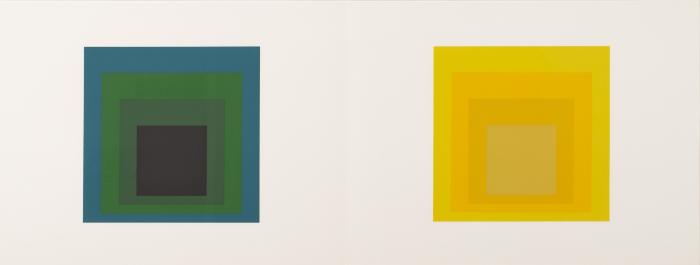[A double image of several squares fitted inside of each other in varying sizes, creating a telescoping effect. The colors of the two squares are solid. In order of largest square to smallest square, the colors on the right include dark teal, dark forest green, dark hunter green and black. The colors on the left include medium dandelion yellow, medium yellow-orange, dark yellow ochre and dark beige.]
Josef Albers
Formulation:Articulation Folio II / Folder 14 , 1972
Artwork Type: Prints
Medium: Color screenprint
Dimensions: 15 x 20 in. (38.1 x 50.8 cm)
Accession #: 19810835 II-14
Edition: 583 / 1000
Credit: Collection of University Art Museum, University at Albany, State University of New York on behalf of The University at Albany Foundation, gift of Yves Istel
Copyright: © Josef Albers
Object Label:
Show Object Label(s)Josef Albers held a sustained interest in pure geometric shapes and color relationships, and
he maintained the utmost precision in his application of paint even when working in the
United States at the time of Abstract Expressionism’s expressive mark-making. In his most
famous series, Homage to the Square, begun in 1950 and continuing until his death in 1976,
he restricted the compositions of the paintings to four semi-concentric squares in order to
focus on our changing perceptions of color. The color of a middle square, for example, may
appear warmer or cooler, or advance or recede spatially, depending upon the hue of its
neighboring inner and outer squares. For Albers, art arises out of this “discrepancy between
physical fact and psychic effect.” This particular color effect, known as simultaneous contrast,
plays a key role in nearly every color work in this exhibition, especially in Chryssa’s Gates to
Times Square.
–When We Were Young: Rethinking Abstraction From The University At Albany Art Collections (1967-Present)
Please contact us at dabbatiello@albany.edu to verify collection holdings and artwork information. If you are interested in receiving a high resolution image of an artwork for educational, scholarly, or publication purposes, please contact us at dabbatiello@albany.edu.
